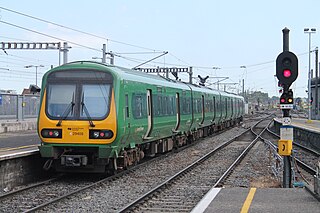
A diesel multiple unit or DMU is a multiple-unit train powered by on-board diesel engines. A DMU requires no separate locomotive, as the engines are incorporated into one or more of the carriages. Diesel-powered single-unit railcars are also generally classed as DMUs. Diesel-powered units may be further classified by their transmission type: diesel–mechanical DMMU, diesel–hydraulic DHMU, or diesel–electric DEMU.
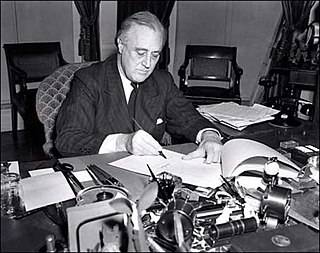
The Lend-Lease policy, formally titled An Act to Promote the Defense of the United States, was a program under which the United States supplied the United Kingdom, Free France, the Republic of China, and later the Soviet Union and other Allied nations with food, oil, and materiel between 1941 and August 1945. This included warships and warplanes, along with other weaponry. It was signed into law on March 11, 1941, and ended in September 1945. In general, the aid was free, although some hardware were returned after the war. In return, the U.S. was given leases on army and naval bases in Allied territory during the war. Canada operated a similar smaller program called Mutual Aid.

Nederlandse Spoorwegen is a Dutch state-owned company, the principal passenger railway operator in the Netherlands. Founded in 1938, NS provides rail services on the Dutch main rail network. The Dutch rail network is the busiest in the European Union, and third busiest in the world after Switzerland and Japan.

A railcar is a self-propelled railway vehicle designed to transport passengers. The term "railcar" is usually used in reference to a train consisting of a single coach, with a driver's cab at one or both ends. Some railway companies, such as the Great Western, termed such vehicles "railmotors".

The Siemens Desiro is a family of diesel or electric multiple unit passenger trains developed by Siemens Mobility, a division of the German Siemens AG conglomerate. The main variants are the Desiro Classic, Desiro ML, Desiro UK and the later Desiro City, Desiro HC and Desiro RUS. The trains are mostly used for commuter and regional services, and their rapid acceleration makes them suitable for services with short distances between stations. The design is flexible, and has become common in many European countries.
The National Railway Company of Belgium is the national railway company of Belgium. The company formally styles itself using the Dutch and French abbreviations NMBS/SNCB. The corporate logo designed in 1936 by Henry van de Velde consists of the linguistically neutral letter B in a horizontal oval.

Limburgish, also called Limburgan, Limburgian, or Limburgic, is a West Germanic language spoken in the Dutch and Belgian provinces of Limburg and in the neighbouring regions of Germany.

Compagnie Internationale des Wagons-Lits, also CIWL, Compagnie des Wagons-Lits, or just Wagons-Lits, is an international hotel and travel logistics company, particularly known for its on-train catering and sleeping car services, as well as being the historical operator of the Orient Express.

"Bulldog nose" is the nickname given, due to their appearance, to several diesel locomotives manufactured by GM-EMD and its licencees from 1939 to 1970. The term originated with EMD F-units, as well as later E-unit models such as the E7, E8, and E9.
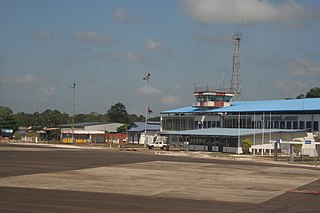
Johan Adolf Pengel International Airport, also known as Paramaribo-Zanderij International Airport, and locally referred to simply as JAP, is an airport located in the town of Zanderij and hub for airline carrier Surinam Airways, 45 kilometres (28 mi) south of Paramaribo. It is the larger of Suriname's two international airports, the other being Zorg en Hoop with scheduled flights to Guyana, and is operated by Airport Management, Ltd./ NV Luchthavenbeheer.

The Railway Museum in Utrecht is the Dutch national railway museum. It was established in 1927 and since 1954 has been housed in the "Maliebaan station", a former railway station.

A control car, cab car, control trailer, or driving trailer is a generic term for a non-powered railroad (US) or railway (UIC) vehicle that can control operation of a train at the end, opposite to the position of the locomotive. They can be used with diesel or electric motive power, allowing push-pull operation without the use of an additional locomotive. They can also be used with a power car or a railcar. In a few cases control cars were used with steam locomotives, especially in Germany and France.

The Blue Angel was the name given to the Plan X class DE-1 and DE-2 diesel railcars formerly used by Nederlandse Spoorwegen. There have been rumors that the name has a connection to the German movie Der blaue Engel, but this has never been confirmed.

Husa Transportation Group is a group of railfreight, logistics and rail services companies founded in 1998, the group's main business arm on foundation was ACTS Nederland BV (ACTS), founded 1989, an open access freight operator in the Netherlands.
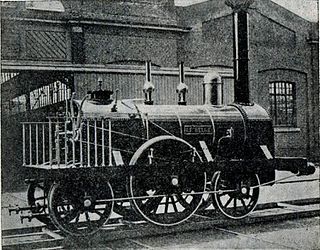
Belgium was heavily involved in the early development of railway transport. Belgium was the second country in Europe, after Great Britain, to open a railway and produce locomotives. The first line, between the cities of Brussels and Mechelen opened in 1835. Belgium was the first state in Europe to create a national railway network and the first to possess a nationalised railway system. The network expanded fast as Belgium industrialised, and by the early 20th century was increasingly under state-control. The nationalised railways, under the umbrella organisation National Railway Company of Belgium (NMBS/SNCB), retained their monopoly until liberalisation in the 2000s.

The Natal Government Railways Class K 0-4-0ST of 1891 was a South African steam locomotive from the pre-Union era in the Colony of Natal.

The NS Class 186 is a type of B-B electric locomotive built by Bombardier Transportation between 2006 and 2014. It is a member of the Bombardier TRAXX family of locomotives, the Bombardier TRAXX F140 MS2 variant.
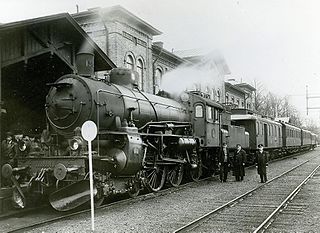
The B class of the Swedish State Railways (SJ) was a type of steam locomotive for mixed traffic, introduced in 1909. 96 locomotives were built for SJ by between 1909 and 1919. The 4-6-0 B class was part of the development of modern superheated locomotives that had begun with the A class in 1906. Intended for fast freight trains and heavy stopping passenger trains, they proved to be highly useful in all types of traffic, and remained in use until the end of steam operations in Sweden.

The E, E2 and E5 classes of the Swedish State Railways (SJ) were three closely related types of steam locomotives. The E class 0-8-0 locomotives were part of the development of modern superheated types that had begun with the A class in 1906, and were intended for both mixed traffic in Norrland and heavy freight trains in southern Sweden. Many of them were rebuilt to the 2-8-0 E2 class between 1935 and 1951, enabling a speed increase from 65 kilometres per hour (40 mph) to 70 km/h (43 mph). Three E class locomotives built for private railways became known as the E5 class following nationalization, as they were slightly heavier than the ones built for SJ.




















